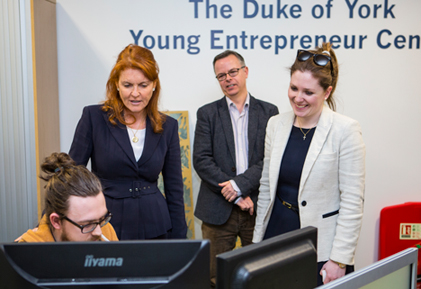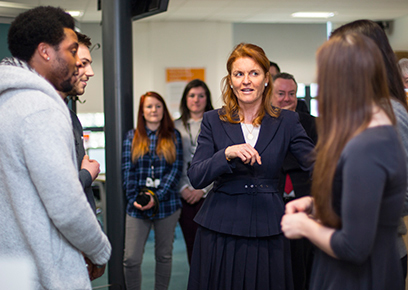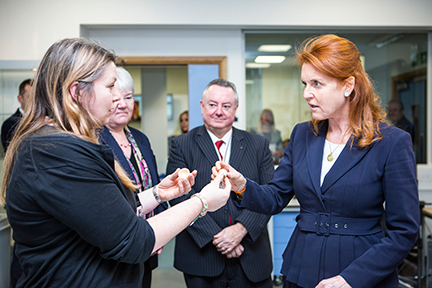The Duchess, the Uni and some Giants lead support for Be a Hero
 The Duchess of York is pictured with (l-r) Leeds Teaching Hospitals Consultant Dr Justin McKinlay, who is also Regional Clinical Lead for Organ Donation in the Yorkshire and Humber region, and Huddersfield Giants players Jamie Foster, Oliver Roberts and Eorl Crabtree and the mascot for the Be a Hero campaign.
The Duchess of York is pictured with (l-r) Leeds Teaching Hospitals Consultant Dr Justin McKinlay, who is also Regional Clinical Lead for Organ Donation in the Yorkshire and Humber region, and Huddersfield Giants players Jamie Foster, Oliver Roberts and Eorl Crabtree and the mascot for the Be a Hero campaign.
Thu, 11 Feb 2016 09:19:00 GMT
The Duchess of York visited the University to promote the Be a Hero organ donation campaign led by Leeds Teaching Hospitals
 AN innovative campaign has led to a massive rise in the number of Yorkshire people who have registered to become organ donors. Named Be a Hero, it was launched at a Leeds NHS Trust but has had an impact throughout the county. The Duchess of York is its patron and when she paid her latest visit to the University of Huddersfield, she held talks about the progress of Be a Hero – and had an encounter with three local rugby stars who were keen to back the project.
AN innovative campaign has led to a massive rise in the number of Yorkshire people who have registered to become organ donors. Named Be a Hero, it was launched at a Leeds NHS Trust but has had an impact throughout the county. The Duchess of York is its patron and when she paid her latest visit to the University of Huddersfield, she held talks about the progress of Be a Hero – and had an encounter with three local rugby stars who were keen to back the project.
Escorted by the University’s Vice-Chancellor, Professor Bob Cryan, the Duchess was shown round its 3M Buckley Innovation Centre, home to a wide range of businesses and research labs.
Also present at the event was Dr Justin McKinlay, who is Consultant in Anaesthesia and Intensive Care at Leeds Teaching Hospitals. He is also Regional Clinical Lead for Organ Donation in the Yorkshire and Humber region, where there are currently some 800 patients waiting for an organ.
In July 2015, Dr McKinlay helped launch Be a Hero, a publicity campaign that was backed not only the Duchess but by a roster of Yorkshire celebrities, including actor Sir Patrick Stewart – Chancellor Emeritus of the University of Huddersfield – and cricket legend Geoffrey Boycott. The University of Huddersfield was among the institutions that lent their support.
 An innovative feature of Be a Hero, said Dr McKinlay, was that it engaged an external marketing company to promote the campaign and this soon resulted in huge extra publicity.
An innovative feature of Be a Hero, said Dr McKinlay, was that it engaged an external marketing company to promote the campaign and this soon resulted in huge extra publicity.
The results so far have exceeded expectations, continued Dr McKinlay. Since the launch of Be a Hero, the numbers of people per month registering as donors in the whole of Yorkshire had risen from 5,000 to 9,000. In Leeds, figures had gone up from 900 to 2,000. Campaigns focussing on new areas of the county will boost the figures still further, it is expected.
Once a person has signed the donor register, then the rate of consent given by their survivors rises to 90 per cent, and the various organs of a single donor can help save the lives of up to nine people, said Dr McKinlay.
During her University of Huddersfield visit, the Duchess of York said she was delighted by the success of Be a Hero and she held talks with Dr McKinlay on future developments. She also met up with three members of the Huddersfield Giants Rugby League squad – Eorl Crabtree, Oliver Roberts and Jamie Foster – who pledged their support for the campaign.
Duchess tours 3M Buckley Innovation Centre
During her visit, the Duchess was introduced to some of the work of University researchers who are based in the 3M BIC. They included Dr Leigh Fleming, who has a speciality in healthcare engineering. She showed the Duchess some of the innovative replacement knee joints that she and her team are developing.
 At the lab of the Arms and Armour Research Institute, its director, the Rev Dr Paul Wilcock, showed how advanced technology could be used to examine and appraise historic weapons – exposing some of them as fakes. He also showed how ancient suits of armour could be scanned in order to produce replicas for sale by the Royal Armouries.
At the lab of the Arms and Armour Research Institute, its director, the Rev Dr Paul Wilcock, showed how advanced technology could be used to examine and appraise historic weapons – exposing some of them as fakes. He also showed how ancient suits of armour could be scanned in order to produce replicas for sale by the Royal Armouries.
3M BIC Technology Director Dr Michael Wilson showed the Duchess the work of the Centre’s 3D Visualisation and Modelling lab, where computer games design student Alice Sjardijn has helped create a 3D reconstruction of a historic Leeds building – the old White Cloth Hall – that is so lifelike it could eventually be used to help Leeds Civic Trust rebuild the original. Dr Wilson also told how a virtual prototype of a new Ginetta sports car was so impressive that it resulted in a substantial number of the vehicles being sold before they had gone into physical production.
The Duchess also toured The Duke of York Young Entrepreneur Centre – The Duke is now Chancellor of the University. She met some of the 40 students, formed into seven teams, who had just concluded a 24-Hour Design Challenge in which they came up with ingenious new concepts based on the Internet of Things. The Duchess chatted to the contest judges just as they were about to go into conclave to settle on the winner.
It was a second recent visit to the University for the Duchess of York. In June 2015, she came to appraise the work of fashion students who had produced designs for an initiative named Key to Freedom that helps women in India achieve financial independence.







